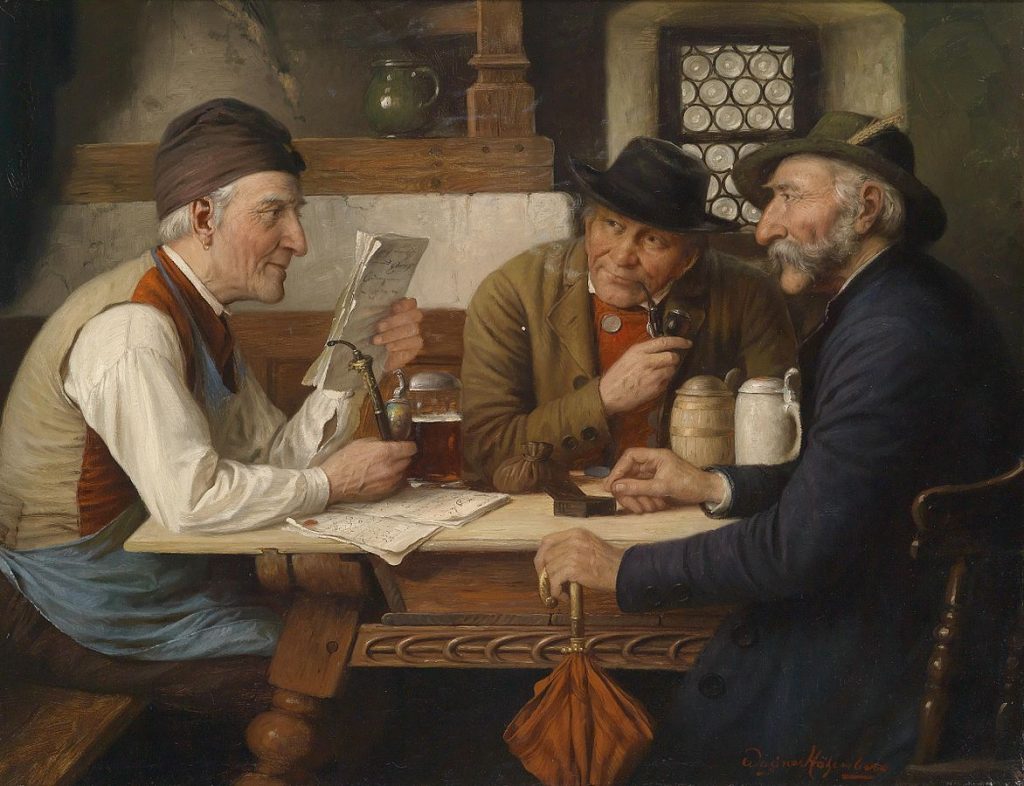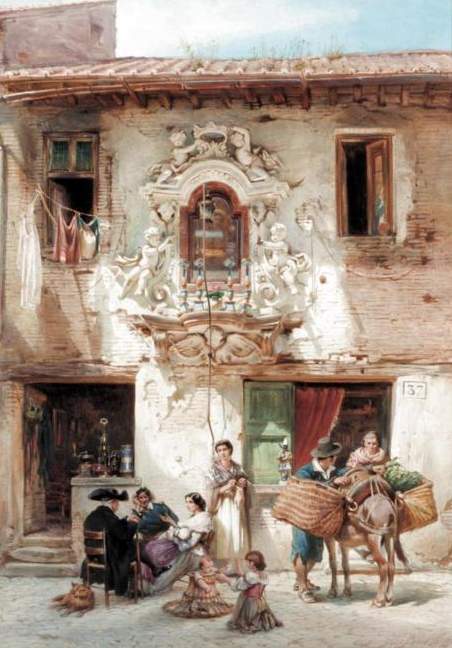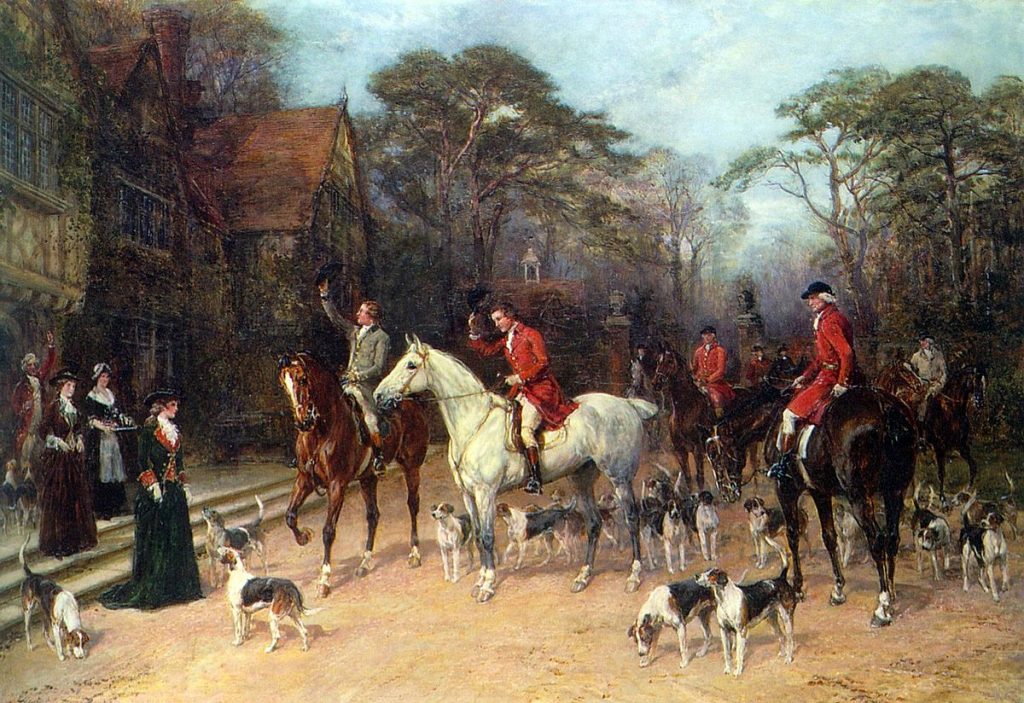“To achieve within the mere natural field a transfiguration of matter, as it were, through an inner illumination of the soul”
How doe this commerce between souls take place? In other words, how do they live their social life?
 When two persons are in contact with each other, however unequal they may be in intelligence, education or persuasiveness, they are able to mutually influence each other.
When two persons are in contact with each other, however unequal they may be in intelligence, education or persuasiveness, they are able to mutually influence each other.
The human body is a wonderful instrument for the expression of the soul. All our ideas, even the most abstract, all our emotions, even the most subtle, are susceptible of being adequately expressed by the primordial action of speech, supplemented and enriched by the inflection of the voice, the expression of the gaze, by gestures and body language, by the bearing and even by the way of walking. Virgil tells us that Dido showed to be a goddess by her simple way of walking: “et incessu patuit Dea …”
A man accentuates his body’s power of expression by attire and adornment. This power gets to be so great that at times it is erroneously seen as irresistible.
When this transparency of the soul becomes clear throughout the body’s way of acting and being, and especially when this transparency reveals a firm, clear and logical soul, you know you are in the presence of what is called a personality. For someone to have personality, to be a personality is to have a soul sufficiently developed to direct, influence and shine in his whole material body. It is to realize within the merely natural field, as it were, a transfiguration of matter through the interior enlightenment of the soul, which is a merely natural but splendid prefigure of the incomparably more radiant and nobler supernatural transfiguration the glorious bodies will have in Heaven, of which a palpable example was given to us in this land of exile by Our Lord at Mount Tabor and also by some Saints.
Dispositions of the soul not only radiate to the body but communicate to objects over which man exerts his influence
The soul is not expressed only through the body. Shapes, colors, sounds, odors, tastes have an analogy with the dispositions of the human soul that is not merely conventional. And for this reason the words that serve to designate states of the human soul are commonly employed to designate, by analogy, properties of animal, vegetable or mineral beings. One can speak of the joyous song of a bird, the laughing aspect of a bouquet of flowers, or simply of a panorama; and likewise one talks about the cheerful laughter of a young woman or child. One can speak of the majesty of a king, of an eagle, or of thunder. Examples of this could be multiplied almost to infinity.
Given this fact, man can apply his action on inferior beings, communicating to them a certain expression. Thus it is certain that animal species tamed by man receive from him as it were a certain amenity of behavior, a certain composure which distinguishes them from their wild counterparts with differences much like those that distinguish a civilized man from a barbarian.
Certain animals, angora cats or Pomeranian lulus for example, acquire as it were a distinction clearly related with the human environments in which they live. Man can also exert a similar action upon certain plants so that you would have wild and cultivated species, which we would rather call cultured species. Man can even communicate a certain expression of soul to perfectly inanimate beings. That is what happens, for example, when he makes a painting with an expression that never existed before on the canvas, brush or ink.
The human soul is such that it is proper to man to communicate this or that expression to all the objects that surround him. Because we are made of soul and body, we want the objects that serve our body to also speak to our soul. Comfortable furniture serves only the body; elegant furniture also serves the soul. A resistant fabric, pleasant to the touch, suitable to the climate, satisfies the body. But the soul has its own requirements and demands that it be beautiful.
Ambience: when we enter a room, we seem to feel the personality of the person who decorated it
The above observations lead us to an essential notion, that of ambience.

Sometimes when we enter a room we seem to feel the personality of the person who decorated it. We say it has ambience. What does ambience mean here? It is the expression of soul that, through the play of shapes and colors a person has been able to communicate to material objects.
In this, as in everything, man imitates God. When we contemplate certain sea panoramas, at night when we look at the sky, we feel an expression of soul that is detached from this world: it is the ambience created by God, through which He expresses Himself to our senses.
Much easier still would be to exemplify with sounds, perfumes, flavors. Saint Paul wrote that wine, drunk with moderation, rejoices the heart of the righteous. The Church uses music to form our piety. The austere scent of incense seems to suit us in prayer. Conversely, Church moralists always warned against voluptuous perfumes capable of arousing softness and lust.
Let us now consider ambience in relation to the essential purpose of contemplation, which is to lead us to God.
 If states of soul are likely to express themselves thus, it is implied that so are virtues and vices. These often manifest themselves in the human face, in the inflection of the voice, gestures, gait. They are susceptible of marking with their own note everything that man does or produces.
If states of soul are likely to express themselves thus, it is implied that so are virtues and vices. These often manifest themselves in the human face, in the inflection of the voice, gestures, gait. They are susceptible of marking with their own note everything that man does or produces.
An ambience cannot be morally indifferent. It will either be good and benefit souls or will be evil and act in the opposite direction
An author’s intemperance or temperance is noticed not only in the fact that he exploits nudity [or does not]. The rhythm of a song can be lascivious in itself, as can the combination of certain perfumes or the complication of certain flavors. The lack of wisdom is expressed not only by the meaning of words but by [a person’s] misaligned gestures, by the extravagant lines or colors of a suit, a piece of furniture, a building.
On this point, as on others, man is subject to error and can brand as voluptuous or foolish things which thus appear to him only because he is not accustomed to them. Nevertheless, a certain voluptuousness or extravagance can actually be found in the thing produced or manufactured by a voluptuous or extravagant man.
Whenever we are in the presence of an “ambience,” precisely because it expresses a state of soul [we must bear in mind that it] cannot be morally indifferent: either it will be good and will benefit souls in their consideration and assimilation of God, or it will be bad and will act in the opposite direction.
This is what can be said of the natural honesty or dishonesty of ambiences. Is it permissible to take another step and speak about specifically Christian ambiences? We think so.

“The lack of wisdom is expressed not only by the meaning of words but by [a person’s] misaligned gestures, by the extravagant lines or colors of a suit, a piece of furniture, a building.”
The ambience expresses the dominant state of mind
When the social life of souls is regular and intense in a particular human group–a family or society—there forms in it as it were a collective soul, that is, a set of convictions some of which are prized as particularly important. Consequently, a collective mentality, a common state of mind exerts a particularly strong influence on all members. [In this group] the vocabulary is defined by the more insistent use of certain words or expressions which sometimes take a specific hue within the group. Not infrequently, even neologisms appear.
On the other hand, the way of dressing, speaking, behaving, all personal preferences tend to receive the mark of commonly accepted principles and especially of those that are dominant. Finally, the material ambience becomes saturated with this influence and gradually the physical setting — family home, social headquarters, etc. – is itself transformed to express the dominant spirit.
 A number of smaller societies, forming together as it were as a society of societies – let us say a set of families in a city – can maintain so to speak a common spiritual commerce which forms the more generic but no less affirmative ambience of the city’s life. The flourishing of a whole set of words, costumes, local habits, the production of handicrafts marked by the local state of mind and even of distinctly local artistic influences, all are the result of a harmonious, defined and active spiritual society. Of course we could rise from the city to the region, from that to the country, and from this to the great zones of culture and civilization.
A number of smaller societies, forming together as it were as a society of societies – let us say a set of families in a city – can maintain so to speak a common spiritual commerce which forms the more generic but no less affirmative ambience of the city’s life. The flourishing of a whole set of words, costumes, local habits, the production of handicrafts marked by the local state of mind and even of distinctly local artistic influences, all are the result of a harmonious, defined and active spiritual society. Of course we could rise from the city to the region, from that to the country, and from this to the great zones of culture and civilization.
Without entering into the inexhaustible debate on the meaning of civilization, culture, artistic style, let us call here social culture the collective state of mind, the collective soul, at least as fertilized and ordered by intellectual work and existing as the characteristic note that also marks intellectual work. Let us call civilization the set of institutions, laws, customs, finally the whole collective way of being while marked by culture. And let us call style the manifestations of art while marked by culture and therefore necessarily related to civilization. Let us call social ambience the overall impression exerted on the observer by the harmonious action of civilization, culture and style, the defined, strong and unambiguous transparency of the state of soul and of the doctrinal principles which are most intrinsic to that society of souls.
The contemplative function of man on this earth is usually exercised based on the ambience, culture, style, and civilization generated by the spiritual interrelations of souls in the temporal order
In this sense we can and must say that ambience, culture, style, civilization, that is, the intrinsically higher goods of human society are the product of social life as a society of souls. These goods are indispensable to the habitual way of being of souls and justify by themselves the existence of society independently of other arguments however legitimate. For no one can conceive a human conviviality that does not tend by its own dynamism to produce these goods. Neither can one conceive normal conditions of life for the soul outside all that could be called ambience, culture, style, and civilization.
 In the same sense we must also say that the contemplative function of man on this earth — apprenticeship, test, and foreshadowing of his eternal function in Heaven — is usually exercised with support from the ambience, culture, style, and civilization. For it is with the aid of all this that man better and more properly assimilates or rejects the various aspects of the environment that surrounds him.
In the same sense we must also say that the contemplative function of man on this earth — apprenticeship, test, and foreshadowing of his eternal function in Heaven — is usually exercised with support from the ambience, culture, style, and civilization. For it is with the aid of all this that man better and more properly assimilates or rejects the various aspects of the environment that surrounds him.
Still in this order of ideas we must add that the formation of ambiences, culture, styles, civilization, which are typically spiritual products, belongs nonetheless to the temporal society; for it is this latter notion that will allow us to continue our reflections and arrive at a very broad perspective on the relations between the Church and civil society.
Part III – this post









